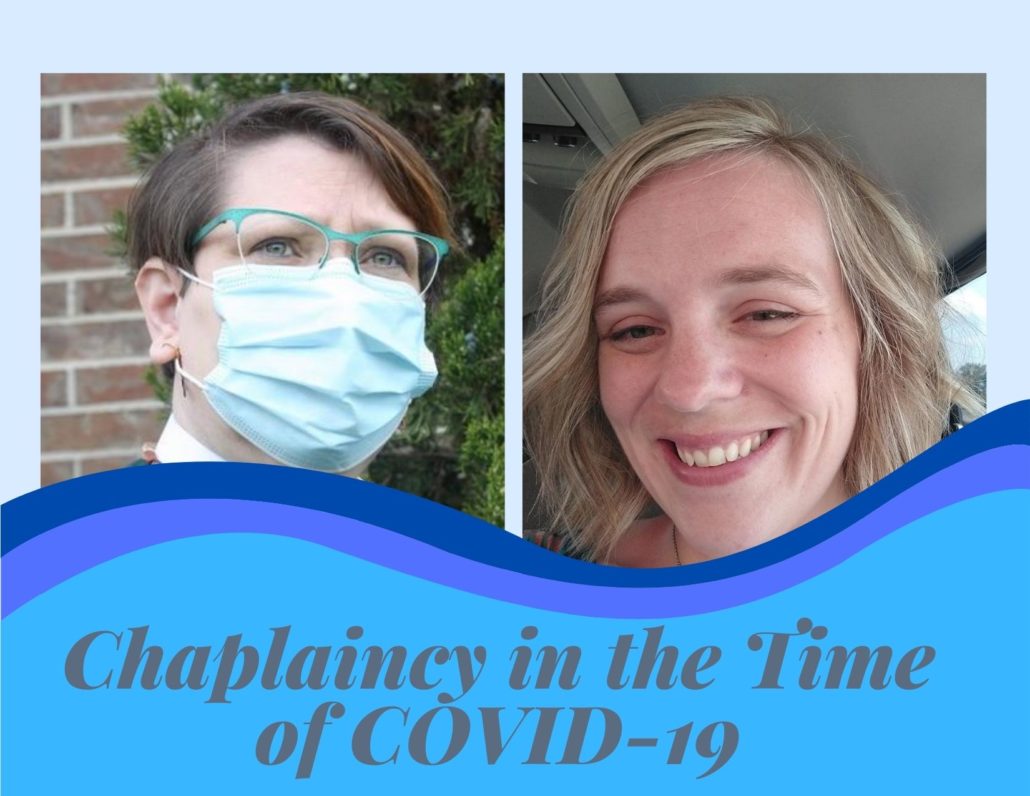
Chaplaincy in the Time of COVID-19
Amid the COVID-19 pandemic, hospitals and other health care facilities have become the front lines, and we have honored and celebrated our health care workers serving our nation’s most vulnerable populations. For the church, the role of chaplain has also been elevated, particularly as most buildings have been shuttered in favor of social-distanced worship and spiritual care. Being present with and helping others awaken to holiness in vulnerable moments is the difficult task of the chaplain in “normal times.” Social distancing creates entirely different challenges.
Two Saint Paul graduates shared their experiences with chaplaincy in the time of COVID-19. Rev. Emily L. Stirewalt (M. Div., 2011), an Elder in the UMC Missouri Annual Conference and whose appointment with her local church ended in June, will begin a residency in the clinical pastoral education (CPE) program at Saint Luke’s Hospital this fall. Kelli Hansen (M.Div., 2016), who received her Spiritual Directors Certification through the Mount St. Scholastica Souljouners program just months after graduating from Saint Paul, is a chaplain at Truman Medical Center at Hospital Hill in Kansas City. She began her CPE at Saint Luke’s Health System in Kansas City in 2016 and will complete more than 2000 hours of post-CPE experience as part of her certification. She will be ordained in the UCC in September 2020.
Although their path to and experience in full-time chaplaincy differs, both alumni share a common purpose of the ministry they are doing. They both understand the importance of meeting people in a particular moment, and regardless of the physical and emotional space between them, forging a connection to help see the Spirit’s dwelling among them and receive the gifts of hope and love. Chaplain Hansen is very clear that she does not “create a sacred space—I invite another person to become aware or mindful that the Holy is already there.” She uses the story of Ruth to help illustrate her work. “I invite them to remember times and places where they can be in touch with their own sense of the Holy. I offer comfort—a tangible version of the hands and feet of God when someone feels so alone in an institution where they are sick, hurt, scared, and unsure what is happening or what will happen next. I offer advocacy, when appropriate, for someone who may not have the courage to speak their voice or doesn’t know they have the right to do so. When Ruth tells Naomi she will go with her through anything, that is a significant way I see the role of chaplain. There is nothing (short of someone saying I do not want your presence) that I won’t accompany someone through.”
Rev. Stirewalt echoed her colleague’s description and offered that “you are meeting the divinity in the humanity” and that for her, even when those needing help are not present, you feel the Spirit move in clinical staff meetings or when you are alone charting visits. She offered a story to illustrate her perspective. “During my first CPE extended unit, I was surprised to be included on the medical team for patients. Nurses and social workers asked me questions and valued my insights. The most striking example was when a doctor asked me if she made the right decision to put an ethics consultation in on a particularly heartbreaking case. She felt as though the patient’s parents were not offering the best care possible to their child. I reassured her decision. She thanked me. I will never forget that patient, the parents, or the doctor. Being included in that small way had a profound effect on me. I believe that is because I saw myself participating in Kin-dom work. I have always understood the reign of God to be a time when all God’s children will be valued fully, a space where all will be free from harm. The doctor was seeking to follow her vow ‘to do no harm.’ I was following mine as well.”
Both alumni shared thoughts on how chaplaincy has changed because of COVID-19. As Chaplain Hansen described it, chaplains “tangibly show up to remind the patient, the staff, and family, that each of these persons matters and has worth.” Rev. Stirewalt’s experience is similar: “The hallways of the hospital, the patient’s rooms, even the Spiritual Wellness office at Saint Luke’s all felt sacred to me during the work of chaplaincy.” Social distancing makes showing up “tangibly” a challenge and requires sacred space that transcends the physical – the rooms and hallways. For some time, all in-person visits were shut down. Even as they have begun to open up, Chaplain Hansen reminds us that phone visits can be “more fruitful that one may imagine” due to the intention to honor sacred space virtually. This environment can “offer a sense of freedom to share deep conversation—perhaps due to less fear of judgment.” However, she notes, social distancing can prevent the element of touch, especially during times of prayer, which can be very healing. Special attention to proper hygiene is essential where an offer of touch is appropriate.
Rev. Stirewalt stresses how the “pandemic has made chaplaincy more relevant than ever before. Chaplains are often the ones who witnessed people taking their last breaths and then told their families that they did not die alone. Our work matters.”
Indeed, it does.
